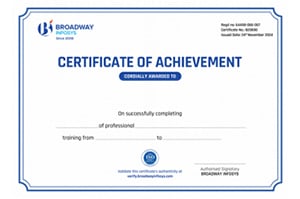
AWS SysOps Administrator Training in Nepal, by Broadway Infosys helps you learn how to navigate and master the powerful tools and services offered by Amazon Web Services (AWS). As a SysOps Administrator, you'll play a vital role in the smooth operation of AWS systems, ensuring that they are highly available, scalable, and fault-tolerant.
Through a fun and engaging learning experience, with AWS SysOps course in Nepal, you'll develop the skills and knowledge necessary to monitor and optimize the performance of AWS resources, manage user access and security, and automate administrative tasks. You'll also learn how to troubleshoot and resolve issues and how to design and implement scalable architectures that meet business needs.
Our expert trainers are dedicated to providing you with the information and abilities required to excel in the fast-moving world of AWS. With a focus on practical, hands-on learning, you'll leave this course with the confidence and ability to tackle even the most complex AWS challenges. So sign up for the AWS SysOps Administrator Training course today and take the first step towards a rewarding career in the exciting world of cloud computing.

Add this credential to your LinkedIn profile, resume, or CV to stand out to recruiters.
